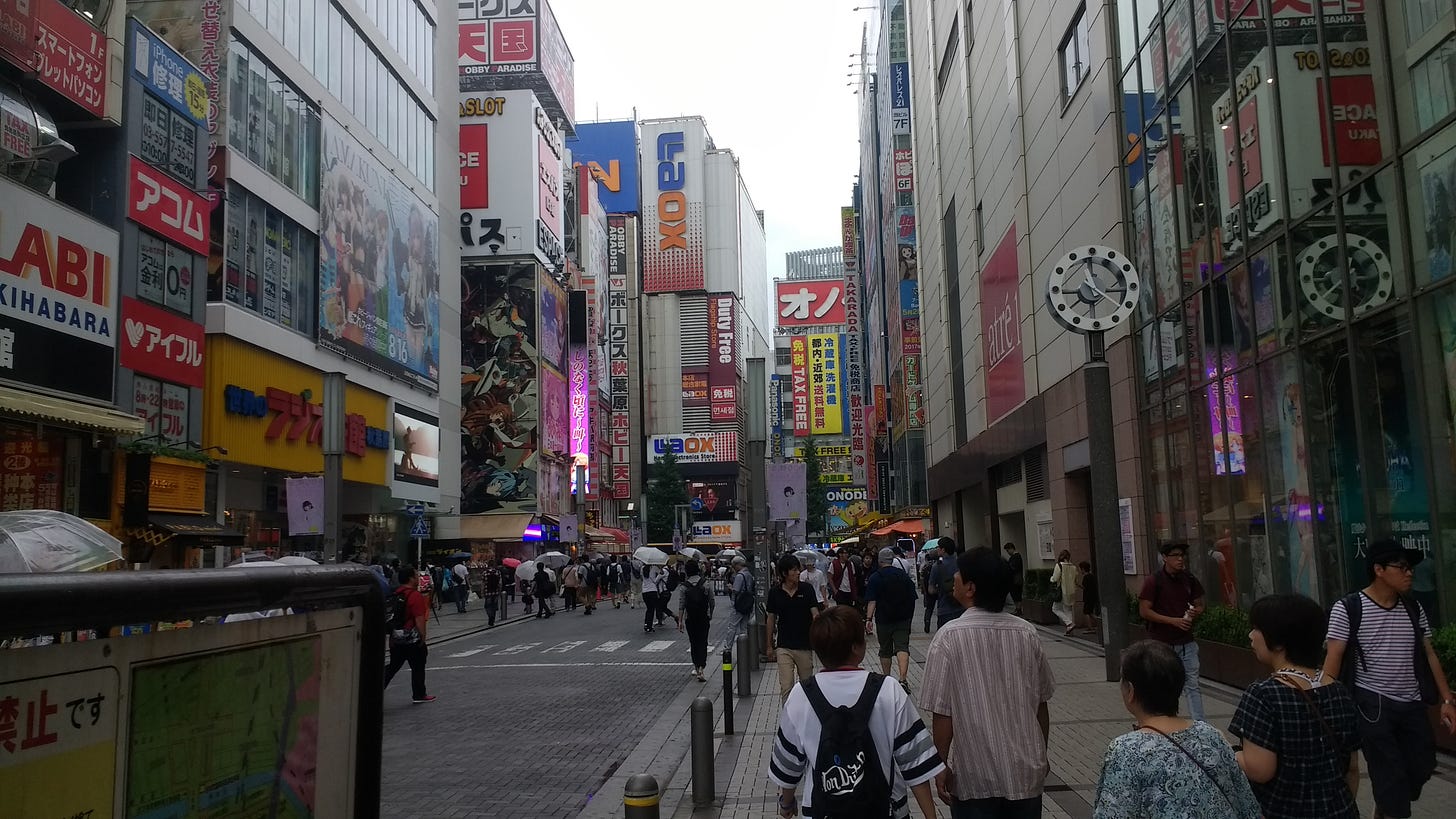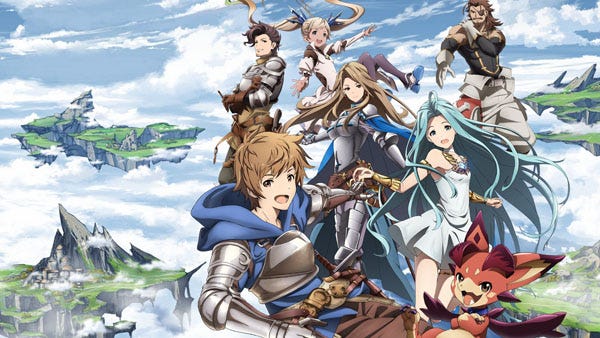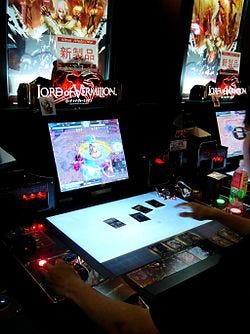A Gaijin's Perspective on Gaming In Japan: Video Games

I'm back, and I'm hideously jet-lagged! I just spent the last two weeks (and some change) wandering Japan. This was my first trip to Japan, my first trip to Asia, and my first time travelling alone internationally. To summarize the more general feelings on the trip: Japan is the best and everyone should go there because it rules in all the ways you think it would and in quite a few surprising ways too.
Now that that's said, I wanted to talk for a little bit about gaming as a subculture in Japan. I visited three large metropolitan cities: Tokyo, Kyoto, and Osaka, each of which is home to at least a million people, with Tokyo being home to nine million. While I was there, alongside my sightseeing adventures I went out of my way to try and peek into what it was like to play games in Japan, both video games and tabletop games.
We'll start with Japan's video game scene, which I think can be divided into three main subcategories: console games, mobile games, and arcades (pachinko and pachislot probably could form a fourth category, but I didn't go into any pachinko parlors because they were very loud and intimidating and had no English signage).
Console gaming seemed relatively common, judging by the frequency of stores selling games. Granted, I spent a lot of time in large media retail neighborhoods (namely Akihabara in Tokyo, and Nipponbashi in Osaka), but most stores which sold any sort of media had at least a floor dedicated to console games. Unsurprisingly, Sony and Nintendo seemed to rule this market, and handhelds seemed to have an edge over consoles.
Even outside of "retro" or "collector's" shops, I found it fairly easy to find games from a couple of console generations ago. Stores I would consider analogous to American big box electronics stores had PS2 and original Xbox games for sale alongside modern releases. I wonder if the urge to upgrade to the latest and greatest isn't as strong in Japan as it is in the States, a trend I also noticed in people having older mobile phones.
The way games were physically presented were also slightly unusual from my perspective. Few games had any sort of spine art aside from the name in plain black text on a white background, and from the looks of it this trend is at least as old as the Gamecube. I wonder if the console game space is considered a bit more of an "otaku" market in Japan, and advertisement is considered less necessary: the fans'll know what they want. The only things that did seem to have stylized spines were Western games, usually quarantined to their own shelves.
Mobile gaming seems to be much more of a thing in Japan, which makes sense. Average people have a decent amount of downtime on trains in the big cities, giving you perfect time to play a little bit of a smaller game. Advertising for mobile games was everywhere, on TV and on billboards and posters in train stations. Games that seemed popular (or, at least, were advertising a lot) included Granblue Fantasy, Final Fantasy XV: A New Empire, Lineage II, Pokemon Go, Clash Royale, and Puzzle and Dragons, among others.

The last point of note for video games is arcades, and oh man, Japanese arcades are intense. Everyone in the arcade gave off a vibe like they've been going to the arcade every day for the last ten years. People were just chain smoking and slamming tall boys and playing Street Fighter or Guilty Gear with skill that was visibly beyond just some dudes button mashing. There was some exemplary skill going on in there, and on top of that, a sense of community, like these guys and gals have been running sets against each other for months, maybe years.
Watching this was interesting, but the stuff I found really cool was a section of games that required more intense setups than a normal home game console. To this end, I ended up playing a lot of Gunslinger Stratos.
The Gunslinger Stratos controllers (and my pants)
Gunslinger Stratos is a third-person arena battle game (a genre that appears to be very in style in Japanese arcades right now), where you control your character through two lightguns with buttons and control sticks built onto them. The game involves a lot of running around and shooting people, but the way you switch weapons is interesting: you have to physically reconfigure the controllers in order to make new weapons appear. For instance, for a character I was playing, placing one gun physically on top of the controller turned both of my one-handed weapons into a single sniper rifle. It was very cool.
Also check out this sweet battle Grandpa
The game I found the most interesting, though, was Lord of Vermillion. Completely unplayable outside of the specialized cabinet, Lord of Vermillion utilizes two screens. The first, a typical screen in front of the player, shows the game scene, a sort of RTS battle between armies in what appeared to be a sort of mythologized Feudal Japanese setting. The cool part, though, is the second screen, which is a sort of tabletop surface between the player and the main display.

On this screen, the guy I was watching was playing actual, physical trading cards, presumably with NFC chips in them, which was creating units in the game space. Moving the cards along the screen moved the units, and it looked like moving them in certain ways activated special abilities (at least, that's what it seemed like, I can't read Japanese after all).
This is awesome. As someone has always been very susceptible to the craze of trading card games, the idea of being able to manifest the characters on your cards in a game space, in the way promised by episodes of Yu-Gi-Oh! back in the day, was incredible to see. On top of that, it conjured up this really cool idea of being able to walk into any arcade in the city with this deck of cards that represents your personal collection, your army, and literally throwing them on the table, bringing up your customized army into this game space, adding that personal customization to an otherwise impersonal gaming space. Combine that with the fact that you have this physical collection, this representation of your characters in the game, and I was hooked.
Seeing how arcades have been able to evolve in Japan since the eighties-style arcades we think of in America is really interesting. In their inception, arcades were cool because you couldn't play these games at home. As home consoles became more and more common, the usefulness of the American arcade was reduced. In Japan, however, that wasn't the case. Perhaps since home consoles never really took off to quite the same degree as in the West, arcades were still needed as a place to play "home console" games.
On top of that, Japanese apartments are usually small and, in order to maintain good relations with your neighbors, quiet. Thus, arcades also provide a space to get rowdy with a bunch of other people playing games together, in a way that would leave you all cramped and your neighbors pissed if you did it at home. Combine this with games that literally can only be played with specialized cabinets, like Gunslinger Stratos and Lord of Vermillion, and arcades held their positions as one-of-a-kind experiences in Japan.
So, yeah, the Japanese arcade space is crazy. And, on the note of public spaces for playing games, next time I'll talk about the Japanese tabletop game space, which I find equally fascinating as well as indicative of Japanese culture in general.